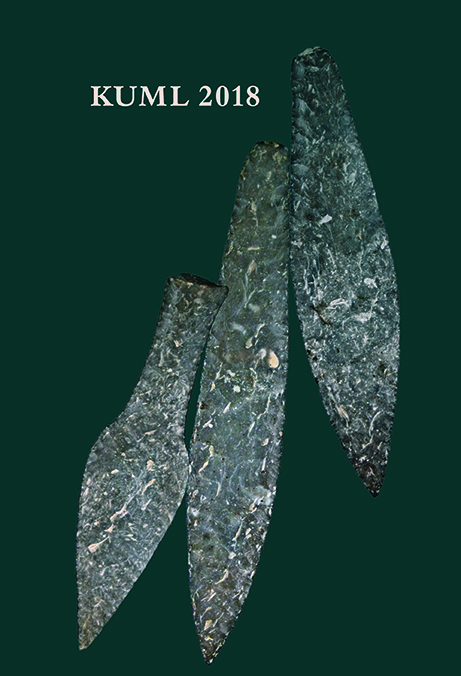Hunting-related rituals in the Early Neolithic
Large pits containing transverse arrowheads
DOI:
https://doi.org/10.7146/kuml.v67i67.110837Keywords:
hunting, ritual, neolithic, transverse arrowhead, pitAbstract
Hunting-related rituals in the Early Neolithic
Large pits containing transverse arrowheads
During the winter of 2013/14 the Historical Museum of Northern Jutland excavated seven large pits at the site of Indkildedalen near Aalborg. The pits contained a total of 74 transverse arrowheads and only a small number of other artefacts. The site had been occupied at least twice during the Neolithic: The first settlement phase is dated to the early Middle Neolithic or late Early Neolithic (see pottery fig. 2), while the second took place at the transition between the Single Grave culture and the Late Neolithic. The pits were probably dug and used prior to or at the beginning of the first settlement phase, before substantial cultural layers were formed. They are dated to the Early Neolithic and/or early Middle Neolithic.
The site is located on a low islet in a former fjord between two of the large moraine hills that define the landscape around Aalborg (fig. 1). In the late Early Neolithic, the fjord had most probably become a valley with quite wet conditions in the lowest parts. Five of the seven pits lay in a NNW-SSE-oriented sequence, but not in a row per se. The remaining two pits were located to the east and west of this sequence. The distance between the northwesternmost and the southeasternmost pits was around 33 m (fig. 3).
The pits were oval in shape. The largest was approximately 2.6 x 2.2 m, while the smallest was approximately 1.2 x 1.0 m. Their depths ranged between 52 cm and 90 cm. Sections showed the bottoms of the pits to be either flat, rounded or funnel-shaped. The pit fills were characterised by light greyish sand and material quite similar to the subsoil. One or more dark-grey layers could be seen in most of the pits (figs. 4-5). Two pits had a dark layer at the top, containing flint waste and potsherds (fig. 6b, c). No transverse arrowheads were found in these latter two contexts.
The fill of the pits was fully or partially sieved (tab. 1).
The transverse arrowheads were found at the bottom of the pits and also higher up in the fill. In addition to the 74 arrowheads, the finds comprise 54 flint flakes, a scraper, a blade, five small potsherds and a fossilised sea urchin. One of the sherds was decorated (fig. 6a).
Based on the composition of the pit fills, the possibility that they could be windthrows was dismissed. The peculiar combination of artefacts in the pits prompts the conclusion that they must have been dug and used as part of a ritual.
Most of the transverse arrowheads recovered from the pits are between 1.9 and 3.9 cm in length. None are shorter and four are longer. The longest measures
5.5 cm (figs. 7-8). Their average length is 3 cm. This is significantly greater than the lengths of transverse arrowheads from the Ertebølle site of Norslund, eastern Jutland, and the Early Neolithic site of Stengade (tab. 2).
The general impression is that the arrowheads are coarse and irregular, but more delicate specimens are present too. No projectile-point-diagnostic macro fractures, as defined by Fischer et al. (1984), were found on the arrowheads.
In pit A1461, differences in the patina of the arrowheads correlated with where in the pits they were found may suggest at least two distinct depositional events. The arrowheads from pit A1461 are shown in figure 11, while those from A1262 and A1527 are shown in figures 9 and 10.
Their great average length and predominantly coarse appearance may suggest that arrowheads employed in ritual contexts were different from those employed in everyday settlement circumstances. This will, however, remain a hypothesis until further arrowheads from settlement and ritual contexts have been analysed.
Deposition of transverse arrowheads has been encountered previously, albeit rarely. At Aldersro, near Aarhus, six transverse arrowheads were found deposited in a spring. These are described as being coarsely made. The site of Indkildedalen probably belongs to the group of causewayed-enclosure-related sites described by Klassen (2014). The rituals at Indkildedalen appear to have been quite focused with respect to the artefact types involved and must have been related to hunting.
Karen Povlsen
Nordjyllands Historiske Museum
Downloads
Published
How to Cite
Issue
Section
License
Fra og med årgang 2022 er artikler udgivet i Kuml med en licens fra Creative Commons (CC BY-NC-SA 4.0).
Alle tidligere årgange af tidsskriftet er ikke udgivet med en licens fra Creative Commons.


